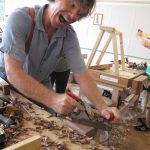We may receive a commission when you use our affiliate links. However, this does not impact our recommendations.
 Our friend Jay van Arsdale sent us this link from what looks to be a Japanese woodworking event similar to Woodworking in America. Do you have a plane that can do this?
Our friend Jay van Arsdale sent us this link from what looks to be a Japanese woodworking event similar to Woodworking in America. Do you have a plane that can do this?
Follow-up from Jay van Arsdale:
The large plane used in the video is called a “beam plane” and is generally used in temple construction where the beam surface is finished with one pass of the plane which is the size of the width of the beam, instead of multiple passes using a narrower plane blade(which works too, but not used on highest end construction, which is what temple building is all about.)
In the planing contests, port orford cedar – “hinoki” in Japan, is used because it has incredible clear grain structure which gives the most consistant thin shavings possible. The shavings are measured with an optical microscope. The record I heard of was a mere 3 microns – smoke dimensions – actually looks like spider webs. My best effort that was measured was about 9-10 micron. Most woods wont even have enough structure at that dimension to make a whole shaving. I routinely plane all types of wood with a japanese kanna – everything from kiri (soft balsa wood catagory) to wenge , curly maple and road grain mahogany. Most of the time the softer woods are more difficult to plane because they compress and don’t cut if the blade is not just right (sharp/polished). I have planed walnut with a plane that wouldn’t cut western red cedar – walnut being more brittle made a shaving, did not compress as the wrc did that didn’t make the same depth cut.
Here are some supplies and tools we find essential in our everyday work around the shop. We may receive a commission from sales referred by our links; however, we have carefully selected these products for their usefulness and quality.










That is pretty unbelievable. Any tiny variation in the sharpening or alignment of the blade, and any slight mistake in the stroke would ruin the shaving. Pretty darn cool.
Amazing !!! and have a look at some of the other posts that come up. The thickness of the blades — one looks about 12 mm (0.5″ to you over there).
It’s a trick; there’s a roll of tissue paper hidden in the plane body. And no, I’m not jealous.
Chuck
That was amazing but no matter how sharp that blade is, it takes a lot of strength and technique to pull that shaving. Ajax thank you for posting this and Jay thank you for sending it to Ajax.
You sharpen the blade with great difficulty.
You may want to know they do not use any figured wood in this competition.
If you want to impress your friends with your sharpening skills and ability to use a handplane, get a chunk of Port Orford Cedar (not a true cedar, but a coniferous tree grown in and around Port Orford just north of the California/Oregon border). It is possible to run off 8′ chips (assuming the board is 8′) smile!
The Japanese use a similar species for these competitions.
How do you sharpen that thing?!!
There is a video on youtube that shows an amazing use for that plane, turning built up blocks of mosiac, marquetry into very thin veneers . The plane scene is located exactly 2 minutes into the film.
http://youtu.be/XPkaxwp7aF0
WOW.. Unbelievable. That has got to leave a nice surface.